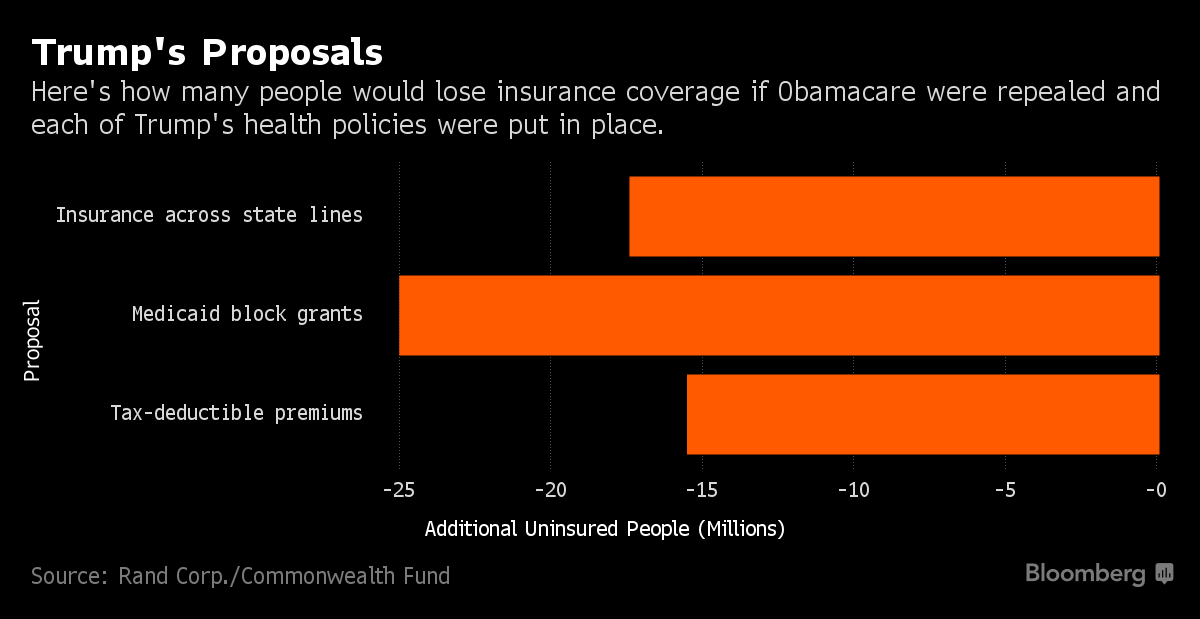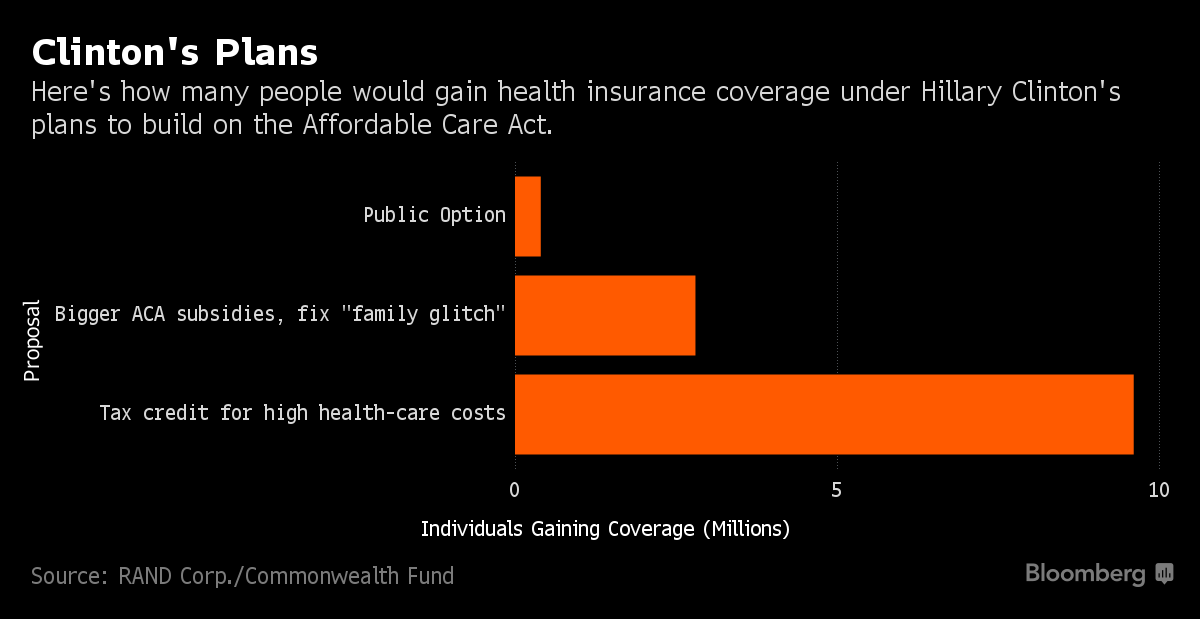If Democrats keep the White House come November, millions of Americans could gain health-care coverage. If Republicans take it back, millions could become uninsured. A new study ran the numbers under the proposals of both U.S. presidential candidates.
Donald Trump’s pledge to repeal the Affordable Care Act, President Barack Obama’s signature health-care law, would result in 19.7 million more people without insurance and widen the federal deficit by $33.1 billion in 2018, according to an analysis conducted by research group Rand Corp. and funded by the Commonwealth Fund, a nonprofit foundation. The Republican nominee’s proposed tax credits would largely benefit higher-income people, the study also found.
By contrast, one of Hillary Clinton’s key health-reform plans could provide insurance to as many as 9.6 million individuals and lower expenses mainly for low- and moderate-income people. It would come at a greater cost to the budget, increasing the deficit by $90.4 billion.
The report offers a detailed look at the policies pushed by the two presidential nominees in a campaign where ugly rhetoric and controversy have often swamped policy discussions. The Affordable Care Act, known as Obamacare, remains a flash point six years after its passage, with Democrats determined to protect it and Republicans vowing to repeal it. The study, coming days before the first Clinton-Trump debate on Monday night at Hofstra University in New York, puts some numbers behind the heated political debate.
“We’ve heard the discussion of repealing the Affordable Care Act for many years,” said Sara Collins, a vice president at the Commonwealth Fund. “The estimates provide people with an idea of what it means to retain the law versus repeal the law. By just the act of repealing, it would lead to millions of people not having coverage.’’


In a statement, the Trump campaign dismissed the study’s findings as “ludicrous” and criticized its approach as a “distraction from the disaster that is Obamacare.” Any replacement to Obamacare would ensure that those now receiving support would be given subsidies or other forms of help to purchase health insurance in the private market through Health Savings Accounts, the campaign said.
“Hillary Clinton will build on the health care progress we’ve made by expanding coverage to millions of Americans who need it and addressing the costs that families face,” said Jacob Leibenluft, a senior policy adviser to Clinton.
Repealing Obamacare
To evaluate Trump’s plans, Rand modeled the effects of repealing Obamacare and replacing it with his proposals. The Affordable Care Act, or ACA, gave states funds to expand the government-run Medicaid program for the poor, and created markets where individuals could buy health plans, often with federal subsidies. It also lets children stay on their parents’ health plans to age 26, requires the purchase of health insurance, and bars insurers from excluding people who are sick, with so-called pre-existing conditions, from buying plans. Clinton’s plans were evaluated as extensions of the current law.
The researchers said they asked both campaigns to help with the modeling. Clinton’s campaign provided answers, while Trump’s campaign referred the researchers to its website, they said. Both campaigns were given copies of the analysis before it was published.
Tax Deduction
In his proposals, Trump would replace the ACA with a tax deduction letting people with health plans fully deduct their insurance premiums from their taxes. He would move to a system of Medicaid block grants, which would cut costs because the federal government would provide states with a limited, fixed amount of money. And he wants to allow insurance to be sold across state lines.
The deduction for insurance premiums would add about $8 billion in costs to the ACA repeal, increasing the federal deficit by an estimated $41 billion, while reducing the number of individuals losing coverage to 15.6 million, the Rand study found. The deduction would lead to lower health costs for higher-income people, who benefit more from reduced taxes, the researchers said.
“Distributionally, it benefits higher income people more than lower income people,’’ Collins said.
Four Proposals
From Clinton’s side, the researchers looked at four proposals, all of which would increase coverage and lower costs for individuals. Three of the proposals would add to the deficit, and one would cut it modestly.
The biggest proposal, according to the study, is a refundable tax credit of as much as $2,500 for individuals and $5,000 for families whose health-care costs exceed 5 percent of income. She also wants to fix what’s called the family coverage glitch, which prevents some low-income families from getting financial assistance.
But the proposal that’s attracted the most attention recently -- a government-run public option health plan to compete with private carriers on the ACA’s exchanges -- has some of the smallest effects. It would provide insurance to 400,000 additional people, while cutting the deficit by $700 million. The Rand analysis assumes the plan would pay providers Medicare rates, which are typically lower than those paid by commercial insurers, helping account for its lower cost.
This article was provided by Bloomberg News.